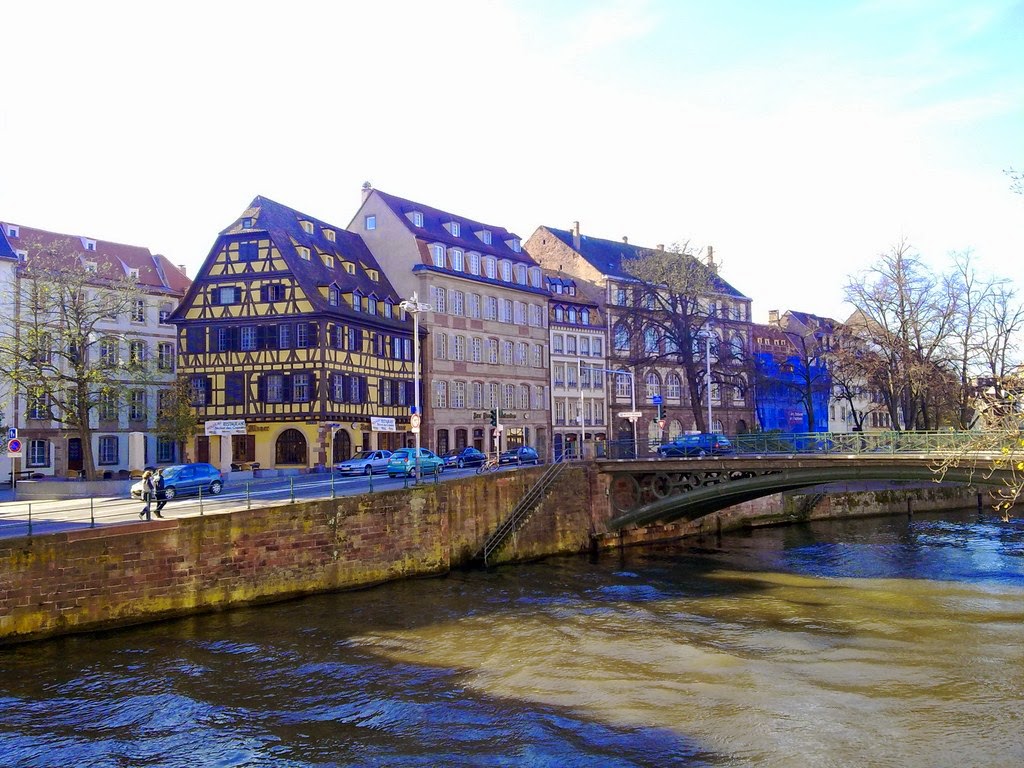Estrasburgo,
capital del Departamento del Bajo Rin y de la Región de Alsacia. Es una de las
plazas culturales, financieras e industriales más importantes de Francia,
segunda en muchos aspectos después de París. Estrasburgo es sede de la Comisión
Central para la Navegación del Rin, Consejo de Europa, Asamblea Parlamentaria
del Consejo de Europa, Tribunal Europeo de Derechos Humanos, Parlamento Europeo,
Eurocuerpo, Defensor del Pueblo Europeo…entre otros organismos internacionales.
Estrasburgo se encuentra a orillas del Rin en su curso bajo, en la frontera con
Alemania. La ciudad cuenta con 58.000 estudiantes universitarios, siendo uno de
los distritos estudiantiles más importantes de Francia. Estrasburgo es la
segunda plaza bancaria de Francia, con bolsa propia y 8 sedes centrales
bancarias. Su centro histórico es Patrimonio de la Humanidad, y es una de las
capitales más importantes del mundo en organización de congresos. Turísticamente
es una de las ciudades francesas más visitadas. Estrasburgo está situada en el
verdadero corazón de Europa y dista 398 km de París, 353 km de Bruselas, 150 km
de Luxemburgo, 181 km de Frankfurt del Main, 146 km de Zúrich y 108 km de
Stuttgart, en línea recta. La ciudad tiene 500.000 habitantes y su área
metropolitana tiene 1.175.000 habitantes, siendo la cuarta ciudad de Francia
por número de habitantes. Estrasburgo nace como Argentoratum el año 12 a.c. a
partir del campamento militar romano asentado en la zona. El fundador fue Druso
el Mayor, hermano de Tiberio y favorito de Augusto como sucesor, pero una caída
de un caballo le provocó una herida en una pierna de la que murió el año 9 a.c.,
a los 29 años de Edad. Druso es antecesor directo de 3 emperadores romanos:
Calígula, Claudio y Nerón. Por los Juramentos de Estrasburgo del año 842 que
sellaba la alianza entre los herederos del Emperador Carlomagno, que desembocó
en el Tratado de Verdún del año 843 que partía el Imperio, Estrasburgo fue
adjudicado a la Lotaringia, territorio integrado más tarde en el Reino de
Germania, abriendo el período de influencia del ámbito germánico en el que
permanecería la ciudad hasta su anexión a Francia durante el siglo XVII. En
1681 se completó la anexión de Estrasburgo y toda Alsacia a la corona de
Francia por las tropas del rey Luis XIV. Tras la Guerra Franco-prusiana,
Alsacia fue incorporada al Imperio Alemán, conservando ese estatus hasta el
final de la Primera Guerra Mundial. Estrasburgo conoció durante ese periodo un
amplio desarrollo urbanístico y cultural. Durante la Primera Guerra Mundial la
línea del frente se encontró alejada de Estraburgo. Tras el armisticio y la Revolución
de Noviembre que llevó a la formación entre el 8 y el 21 de noviembre de 1918
de un consejo para el gobierno de la ciudad, Estrasburgo retornaría a la
soberanía francesa a partir del 22 de noviembre de 1918. Estrasburgo fue
nombrada sede del Consejo de Europa en 1946, resultando ser la ciudad de la
reconciliación franco-alemana.
Strasbourg, capital of Bas-Rhin and the Alsace
region. It is one of the most important cultural, financial and industrial
spaces of France, second in many ways after Paris. Strasbourg is the seat of
the Central Commission for Navigation on the Rhine, Council of Europe,
Parliamentary Assembly of the Council of Europe, European Court of Human
Rights, European Parliament, Eurocuerpo, Ombudsman ... among other
international organizations. Strasbourg is located on the Rhine in its lower
course, on the border with Germany. The city has 58,000 undergraduates, one of
the most important school districts in France. Strasbourg is the second largest
banking center in France, with its own Stocks Market and 8 bank headquarters.
Its historic center is a World Heritage Site, and is one of the most important
capitals of the world in organizing conferences. Touristically is one of the
most visited French cities. Strasbourg is situated in the very heart of Europe
and lies 398 km from Paris and 353 km from Brussels, Luxembourg 150 km, 181 km
from Frankfurt am Main, Zurich 146 km and 108 km from Stuttgart. The city has
500,000 inhabitants and its metropolitan area has 1.175.000, being the fourth
largest city in France by population. Strasbourg was born as Argentoratum the year
12 BC from the Roman military camp settled in the area. The founder was Nero
Claudius Drusus, brother of Tiberius and Augustus favorite successor, but a
fall from a horse caused a wound in a leg from which he died the year 9 BC, at
29 years of age. Drusus is direct ancestor of 3 Roman emperors: Caligula,
Claudius and Nero. For the Oaths of Strasbourg of 842 that sealed the alliance
between the heirs of the Emperor Charlemagne, which resulted in the Treaty of
Verdun of 843 which divided the Empire, Strasbourg was attached to Lorraine,
territory integrated later in the Kingdom of Germania opening the period of
Germanic influence in which the city would remain until its annexation to
France during the seventeenth century. In 1681 the annexation of Alsace to the
crown of France was completed by the troops of King Louis XIV. After the
Franco-Prussian War Alsace was incorporated into the German Empire, retaining
that status until the end of World War I. Strasbourg knew during this period a
large urban and cultural development. During World War I the front line was
found away from Strasbourg. After the armistice and the November Revolution
which led to the formation between 8 and 21 November 1918 of a council for the
city government, Strasbourg would return to French sovereignty as from November
22, 1918. Strasbourg was named headquarters of the Council of Europe in 1946,
proving to be the city of Franco-German reconciliation.


.jpg)
.jpg)




























































































No hay comentarios:
Publicar un comentario